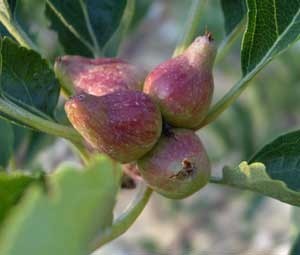This is my first apple tree. This is the first fruit that it is growing. I don't know if it is one apple or many together? Any ideas?
Hardiness Zone: 7b
Christine from Sanremo, Italy
Christine,
Wow! What an interesting picture. A fruit grower or arborist can tell you for sure, but I'm going to take an educated guess as to what could be happening. Apple blossoms form in clusters of five (or on rare occasions, six). The first, and usually the largest bloom to open is called the king bloom. If all goes according to nature's plan, the king bloom sets fruit first, which suppresses the setting fruit of the other blossoms. If all five blooms set, you end up with 5 smaller fruits, the other four blooms are usually removed in order to avoid this. Perhaps in your case, all five blooms set fruit and for whatever reason (maybe exemplary growing conditions) they all received enough nutrients to grow a decent size. As they continued to grow, the cluster of apples then developed a distorted appearance for lack of having any elbow room. My guess is that this is the only cluster on the tree that looks like this.
Still another possibility is that early in the fruit's development your area experienced a sudden short burst of chilly temperatures-maybe a slight frost. When this happens and the skin of the fruit is damaged, apples (and also pears) sometimes develop what is known as frost rings. This doesn't kill the blossom or the fruitlet, but it can cause tough callus-like patches on the skin that constrict and distort the fruit as it grows. In either case, the apples are still safe for consumption.
Ellen

About The Author: Ellen Brown is our Green Living and Gardening Expert. Click here to ask Ellen a question! Ellen Brown is an environmental writer and photographer and the owner of Sustainable Media, an environmental media company that specializes in helping businesses and organizations promote eco-friendly products and services. Contact her on the web at http://www.sustainable-media.com
Add your voice! Click below to answer. ThriftyFun is powered by your wisdom!
Based on your photo, it looks like you have a pear tree. If you planted it yourself or had someone plant it and still have the tags or paperwork you could check its botanical name. If it is an apple it will be in the "Malus" family and if it is a pear it will be in the "Pyrus" family.
Are you sure it is an APPLE Tree?
I thought it looked more like a pear tree, but even pear trees don' grow the fruit in clusters quite like that.
I don't believe that it's a pear tree. Pears grow with the narrow end (stem end) attached to the tree. It looks as though the bud end is facing out. Apples do often grow in clusters like this, but these seem to be deformed. Are all the clusters like this, or is this the only one?
Hi, I asked my friend who is a nursery owner and this is what he said:
It may be poor pollination. Cut one open and see how many seeds there are. There should be about 10
Apples are self incompatible and must be cross pollinated. Pollination management is an important component of apple culture. Before planting, it is important to arrange for pollenizers - varieties of apple or crabapple that provide plentiful, viable and compatible pollen. Orchard blocks may alternate rows of compatible varieties, or may plant crabapple trees, or graft on limbs of crabapple. Some varieties produce very little pollen, or the pollen is sterile, so these are not good pollenizers. Good-quality nurseries have pollenizer compatibility lists.
It is definately an apple tree. Thank you for the valuable information. We will look into it directly.
Add your voice! Click below to answer. ThriftyFun is powered by your wisdom!